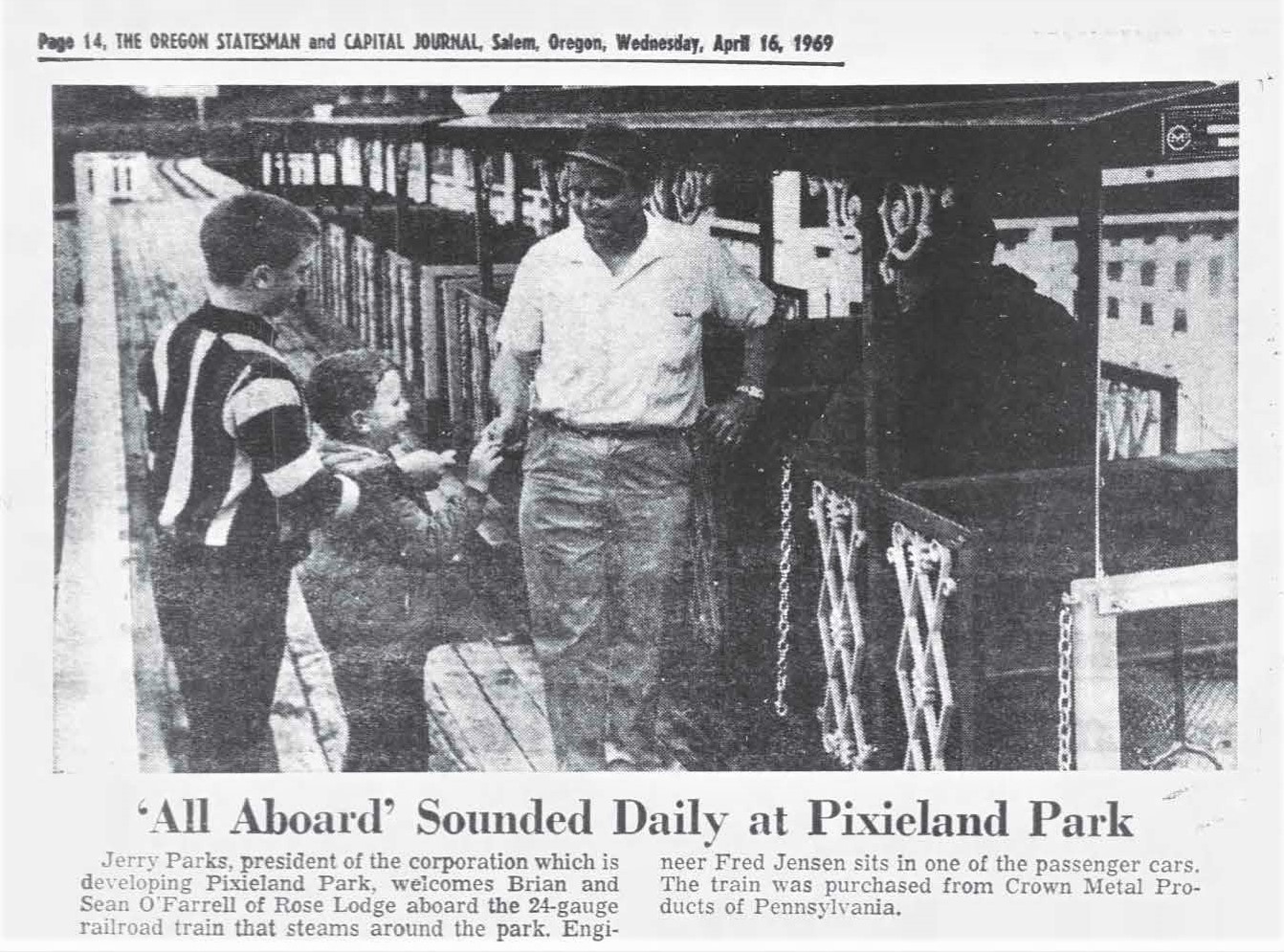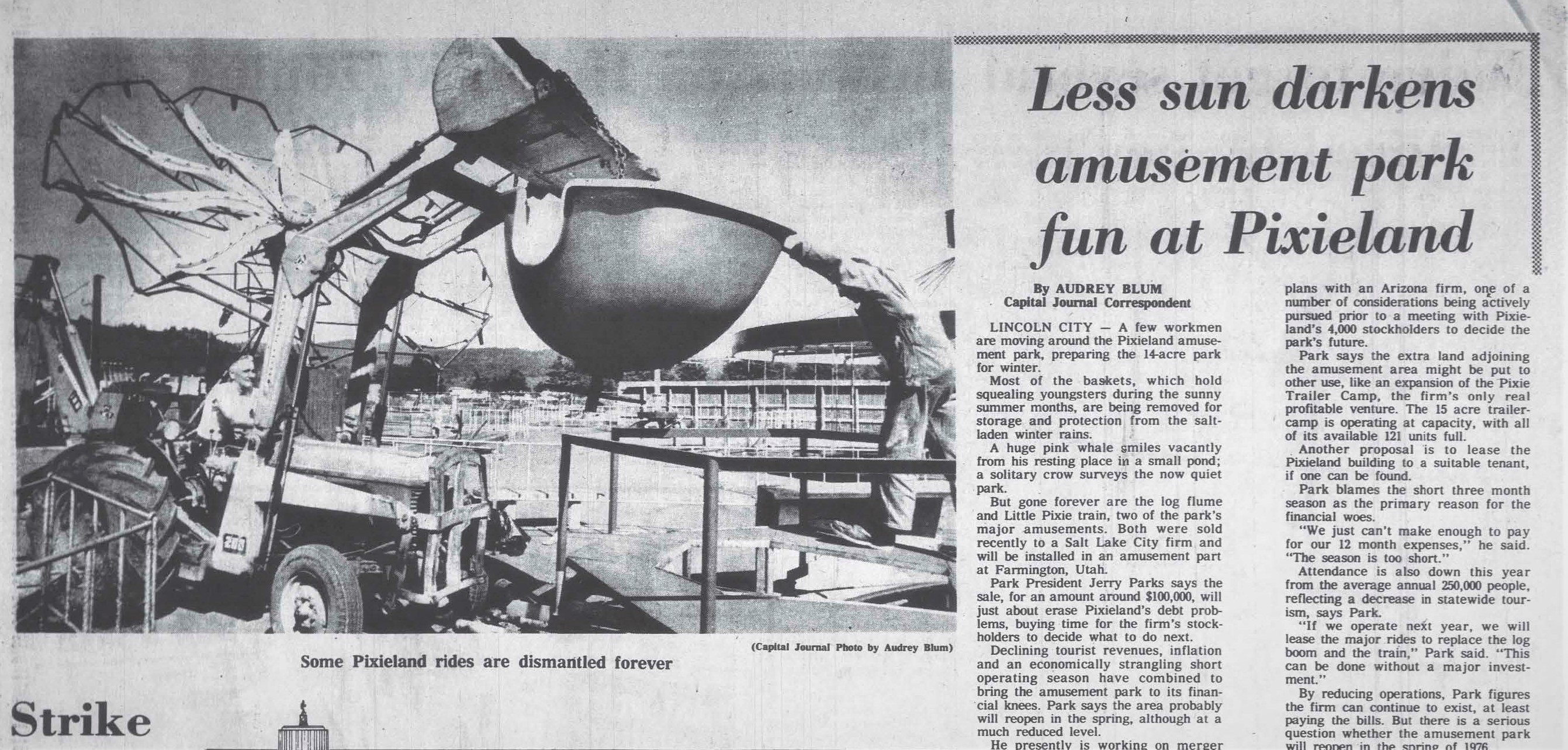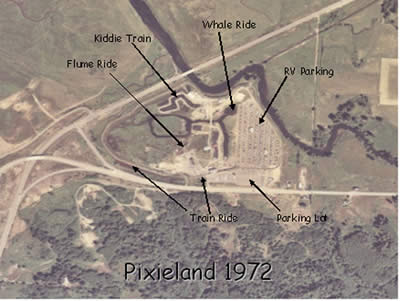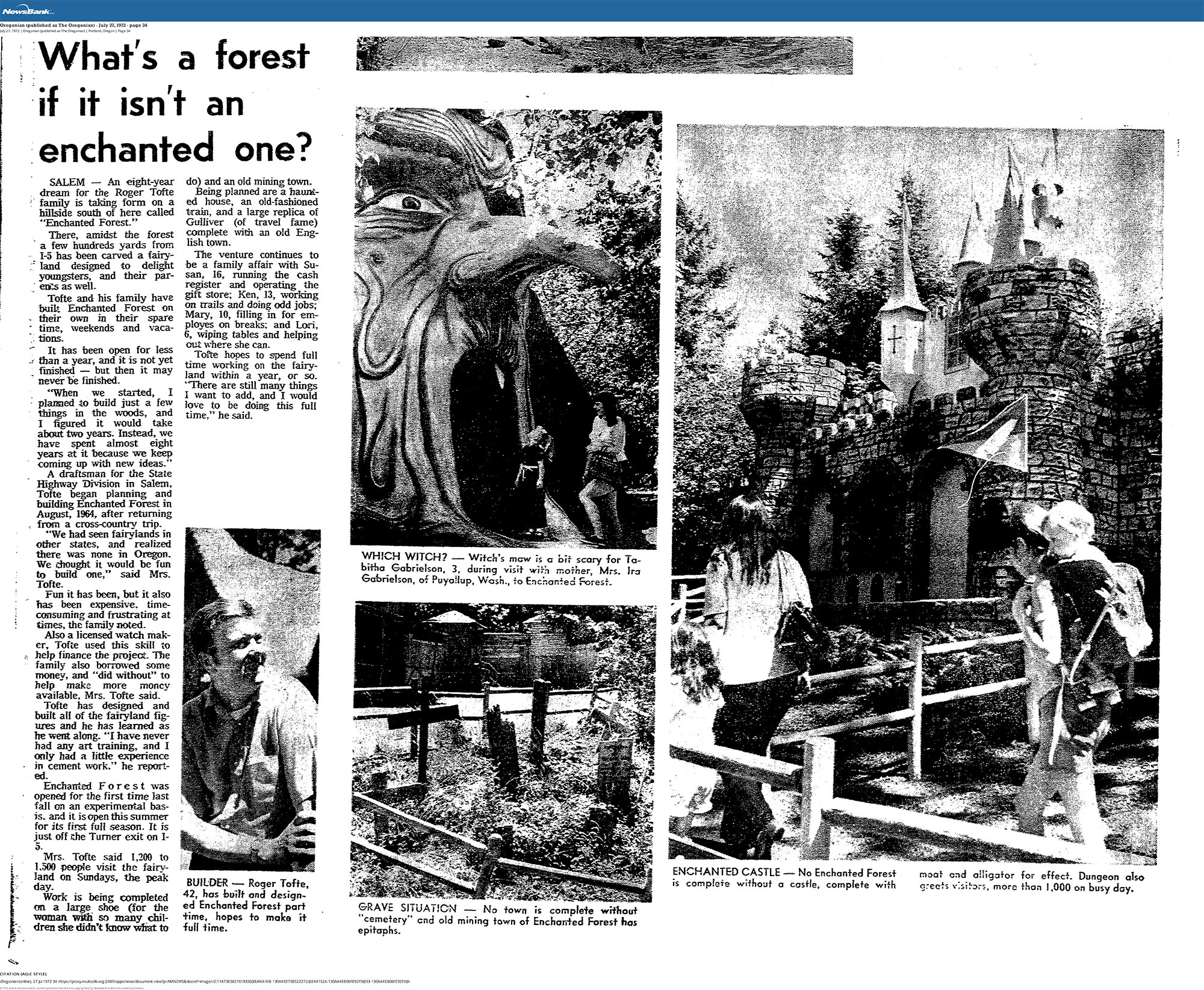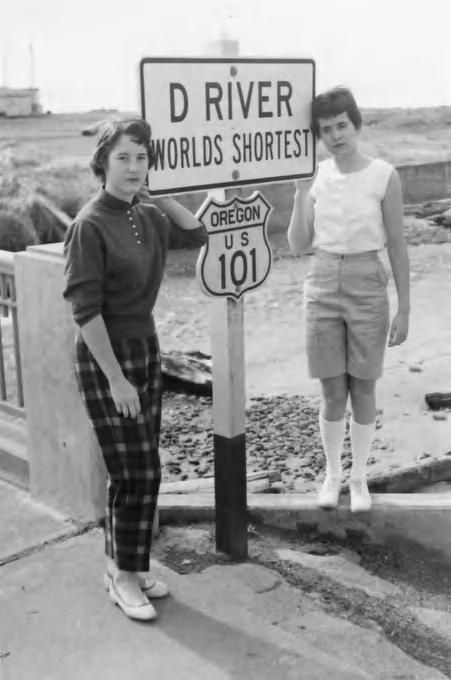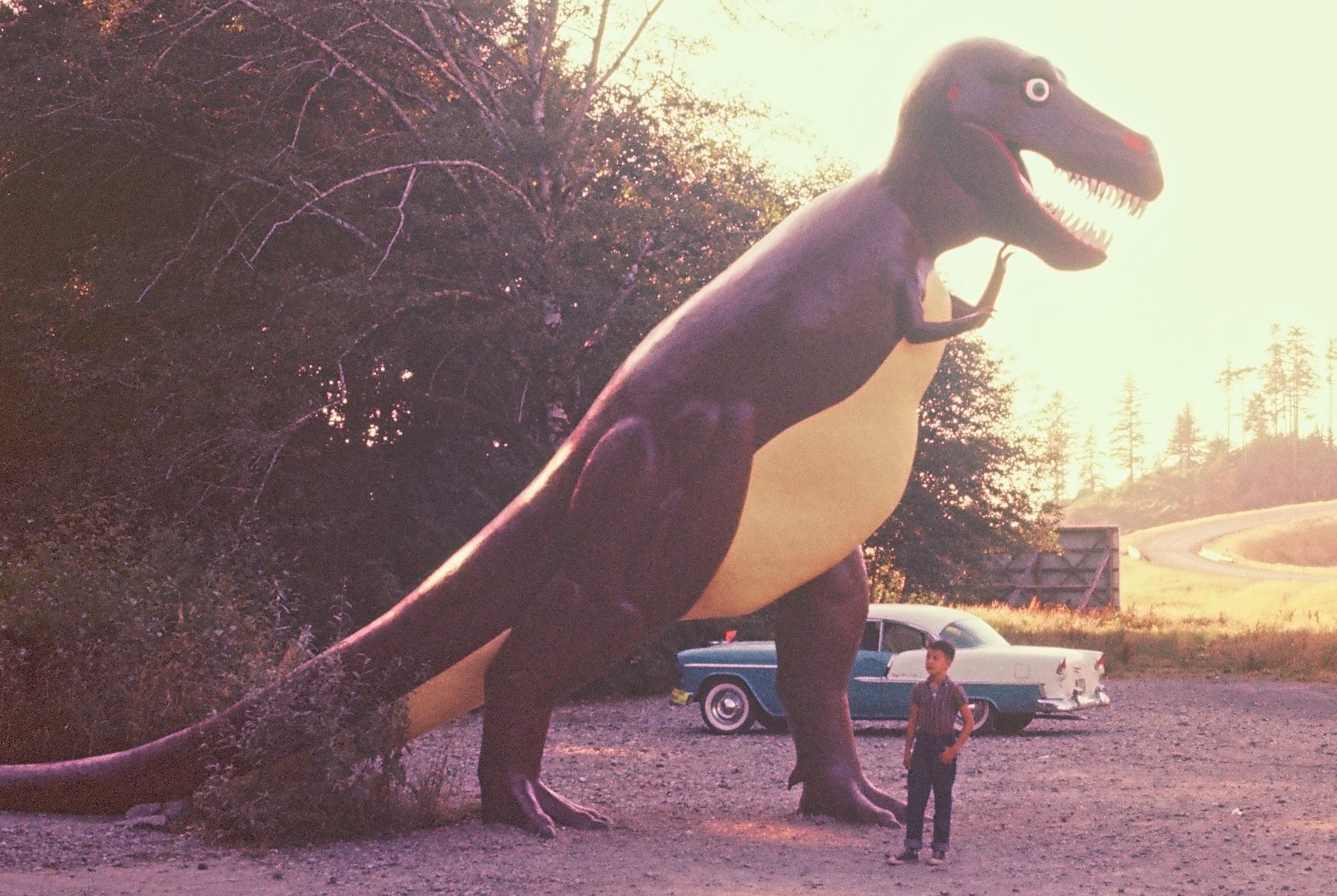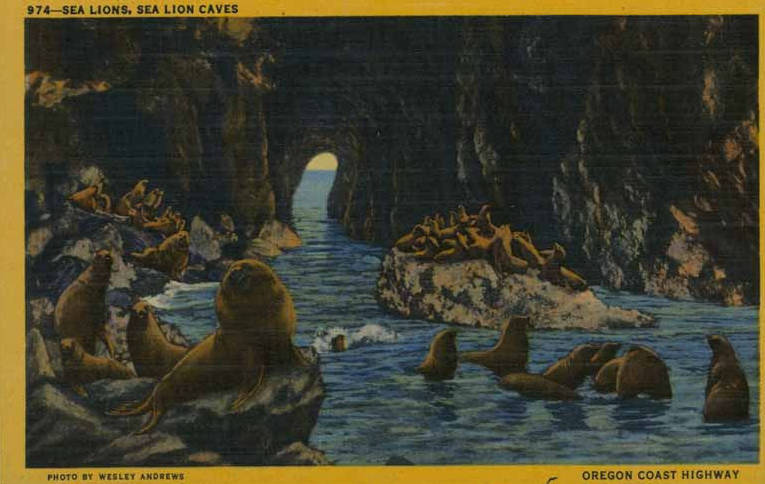Pixieland was a short-lived but popular amusement park on the Oregon Coast northeast of Lincoln City, between the Salmon River and Highway 18. The park, which operated from 1969 to 1975, was a major regional tourist attraction known for its colorful décor, fun rides, and other amusements that catered to children.
Pixieland grew out of the success of the Pixie Kitchen, a seafood restaurant on Highway 101 in Wecoma Beach (now part of Lincoln City). Jerry and Lu Parks opened the restaurant on May 21, 1953, purchasing it from T.C. Gallagher, who had opened it in 1948 as Pixie Pot Pie, a take-home pie service. Under the Parks’ management, the restaurant became a well-known coastal eatery that focused on affordable meals and a fairytale-themed décor. Funhouse mirrors framed the entrance, and the dining room’s large windows looked out on the Pixie Garden, a fantasyland of pixies in a motorized diorama. Placemats folded into pixie hats, the menus had pixies scampering over the page, and there were surprise candy treats for children. The restaurant’s slogan was “Heavenly Food on the Oregon Coast.”
The Pixie Kitchen was so popular that Jerry Parks decided to build an amusement park. He purchased 57 acres of Salmon River wetlands in 1964 and spent $300,000 diking, draining, and filling the land. In 1966, he told the Lincoln City News Guard that Pixieland would include “pioneer-type buildings,” train rides, and a larger restaurant. He hired two people who had worked at Disneyland to help design and build the park and to oversee its operation. To finance the project, Parks received a $250,000 Small Business Administration loan and offered 500,000 shares of stock at a dollar a share, which sold out in an in-state offering in three weeks. The final cost of the park was an estimated $2 million.
Pixieland, which Parks described as a “Fairytale Story of Oregon,” opened on May 15, 1969. Governor Tom McCall dedicated the park on June 28, and a plaque reading “Dedicated to the families of Oregon” was erected on the park’s main street. In addition to the Darigold Barn, where ice cream was sold, attractions included Arcade Amusements, the Blue Bell Opera House, the Phillips Candy Kitchen, and the Franz Rest Bread Hut, where visitors could watch the Log Flume Ride. Scones were sold at Fisher’s Scone, a round building topped with a Scottish tam made of fiberglass and measuring thirty-two feet in diameter.
Little Pixie—a three-car, 1890s-style steam locomotive originally named Little Toot—took passengers on a mile-long ride atop the dike that surrounded the park. The track required some 46,000 pounds of rail, and the train reportedly used 700 pounds of coal and 300 gallons of water each operating day.
The Log Flume Ride, the only such amusement ride on the West Coast at the time, was perhaps the best-known attraction. Visitors in “log” boats were carried thirty-five feet above the theme park before descending a waterslide into a long splash basin. The ride, which had eight boats, was designed specifically for Pixieland and cost $200,000.
Pixieland began to collapse financially in 1973, and Parks solicited offers from out-of-state buyers. The park had never shown a profit, Parks said, even from the 121-unit mobile home park that had been the financial mainstay of the business. In addition, the drizzly coastal weather had mandated a short operating season, and upkeep was constant due to the corrosive damp. Parks sold Little Pixie and the Log Flume Ride in 1974 to the Lagoon Corporation in Salt Lake City and closed the park for the winter. He opened it again in May 1975, with about 40 percent of the attractions, which now included a new Ferris wheel—the largest manufactured in the United States—and other “thrill” rides such as the Looper and the Tilt-o-Wheel. Miniature whale boats were planned for a manmade lake. The pared-down Pixieland operated for a few months, but the new rides were not enough to save it. Parks left the business by 1977, and the abandoned buildings slowly collapsed into the invading Himalayan blackberries. The RV park stayed in business until 1981, when the U.S. Forest Service purchased it and the Pixieland property.
Under the Cascade Head Scenic Research Area Act, the Forest Service was mandated to restore the Salmon River estuary, which included the Pixieland site. The buildings were torn down, leaving behind concrete foundations, ditches, dikes, and the tide gate. In 2007, mountains of blackberries were removed, along with the remaining infrastructure, which included 4,000 cubic yards of asphalt roads and parking lots. In 2011, the Forest Service removed 2,000 linear feet of dikes, 2,300 linear feet of ditches, and the last tide gate, completing the restoration of the site and integrating it into the Salmon River estuary.
The Pixie Kitchen changed hands many times and finally closed in 1988. It was destroyed by fire in the 1990s and was converted to a parking lot. But Pixieland and the Pixie Kitchen live on. The Kiwanis Club of Lincoln City organizes a two-day Pixiefest fundraiser each year, where children can ride ponies and play games and people can buy Pixie Kitchen menu reprints, postcards, placemats, and a cookbook. Two of the Pixieland whaleboats are on display in front of the Historic Anchor Inn in Lincoln City.
-
![]()
Proposed layout of Pixieland, July 19, 1967.
Courtesy Portland Oregonian
-
![]()
Jerry Parks and his Pixieland train, April 16, 1969.
Courtesy Oregon Statesman
-
![]()
"Less sun darkens amusement park fun at Pixieland," September 21, 1974.
Courtesy Salem Capital Journal
-
![]()
Aerial of Pixieland, 1972.
Courtesy US Forest Service
Related Entries
-
![Enchanted Forest]()
Enchanted Forest
The Enchanted Forest theme park in Turner, Oregon, just south of Salem …
-
![Lincoln City]()
Lincoln City
Early in the twentieth century, a string of small beach towns with thei…
-
Prehistoric Gardens
Prehistoric Gardens, with its twenty-foot-tall concrete Tyrannosaurus g…
-
![Sea Lion Caves]()
Sea Lion Caves
Eleven miles north of Florence on U.S. Highway 101 are the remains of a…
Related Historical Records
Map This on the Oregon History WayFinder
The Oregon History Wayfinder is an interactive map that identifies significant places, people, and events in Oregon history.
Further Reading
"Pixieland, 1971." Youtube. Home video of Pixieland, by Mike Leon. https://www.youtube.com/watch?time_continue=206&v=oxjr3as0biA&feature=emb_title
Ellingson, M.F. and Barbara J. Ellis-Sugai. Restoring the Salmon River Estuary: Journey and Lessons Learned Along the Way, 2006-2014. USDA, United States Forest Service, 2015.
"Pixieland owner to sell out." Salem Capital Journal, May 5, 1973, p.13
Kiwanis Club of Lincoln City, Pixiefest website: https://pixiefest.com/
“Weird Tales of Pixieland, Central Oregon Coast History, Part I.“ Oregon Coast Beach Connection, October 3, 2018. https://www.beachconnection.net/news/wpixie100318_238.php
“Kooky Oregon Coast History: Lincoln City’s Pixieland, Part Two.” Oregon Coast Beach Connection, October 4, 2018. https://www.beachconnection.net/news/pixiehist100418_454.php
“Pixieland.” PdxHistory.com. http://www.pdxhistory.com/html/pixieland.html
Steinberg, Nancy. “Pixieland: From Log Flume Ride to Flooding Tide.” Oregon Coast, November/December 2011.
Verzemnicks, Inara. “Invisible Cities: Pixieland, the Mythical Amusement Park on the Oregon Coast.” The Oregonian, January 22, 2008.


